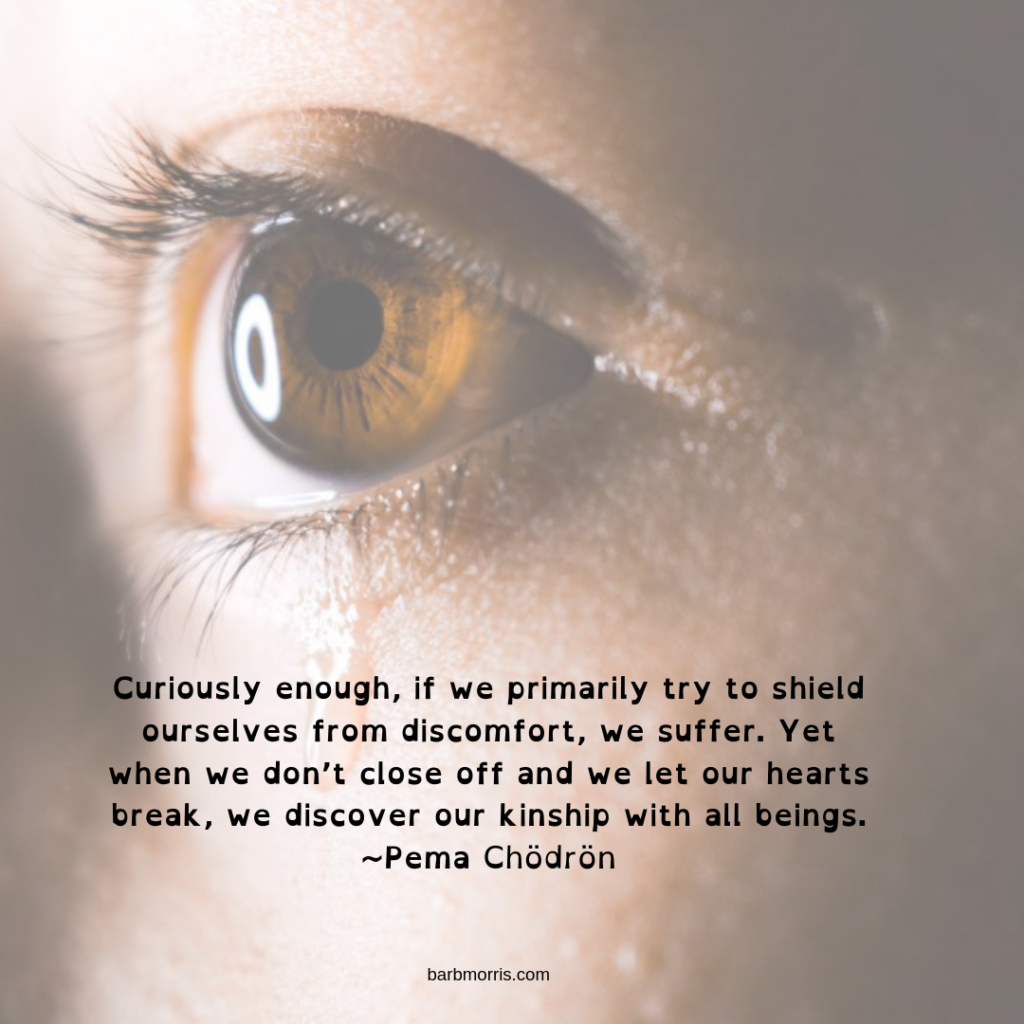
Are you feeling sad? I am. Lately, I’ve been feeling sad pretty much constantly. I have abundant reasons for sadness these days – gun violence, climate chaos, divisive politics, and the accumulated losses of my last six decades among them.
But I don’t enjoy feeling sad. I’d really like not to feel so damn sad. But not feeling sad doesn’t work. If I don’t feel my sadness, it just keeps hanging around asking for attention, getting more and more demanding.
In my 60s, I’m learning to accept that sadness and her cousins grief and pain are necessary ingredients of this whole embodied enchilada.
I’m starting to suspect that sadness will be my constant companion for the remainder of my journey, and the healthiest course of action is just to plan for that.
Because to reject sadness – to numb it through distraction or addiction, to push it away – is to reject Joy.
Sadness, pain, and grief are necessary companions of joy and love. They walk together. They’re a package deal. We simply cannot have the good feelings without the awful ones. It just doesn’t work that way. We don’t work that way.
Yes, sad or mad or scared feelings are uncomfortable. They hurt. They make us cry and rage and cower. They feel terrible. And most of us weren’t taught how to live with the discomfort of so-called negative emotions. We were likely taught to push away sadness, fear, and anger in all their permutations.
But resisting our uncomfortable feelings makes us brittle and mean. Resisting our uncomfortable feelings makes us less compassionate toward ourselves and other beings. Resisting our uncomfortable feelings turns us into pale ghosts of who we could be – shadows afraid of our own shadows.
So, let’s learn how to feel the hard stuff. Let’s be the bad-ass warriors we are, and learn to be with the emotions that make us dig deep and grow up. Learning to be with sadness, especially, is how we heal.
Not wallowing. Not denying. Just giving sadness a place at our abundant table.
Feelings are meant to be felt, not rejected, stuffed, and numbed. Your emotions will not overwhelm you if you feel them. Feelings are simply sensations that carry information.
You can survive a feeling. You can be with yourself, all of yourself, and receive the gifts of your uncomfortable feelings.
Here’s one way to be with a painful feeling (adapted from Dr. Tara Brach’s RAIN process):
- 1. Notice the feeling. This is often the hardest step, because we’re so used to pushing painful feelings away.
- 2. Allow that feeling to be what it is. It’s surprising how quickly feelings pass when we just allow ourselves to have them without judging ourselves.
- 3. Give kind, curious attention to the feeling. Where does it show up in your body? Is it hot or cold? Heavy or light? Open or closed? Does it have a color? A shape? A message for you?
- 4. As the feeling wanes, give yourself kindness. You might want to mentally tell yourself you’re safe, I love you, I’m sorry, I’m here. You might want to put your hand on your heart. Experiment to find what words and gestures bring you comfort.
And why do we do this, again? Why would we choose to feel challenging feelings?
Buddhist teacher Pema Chödrön puts it this way:
When inspiration has become hidden, when we feel ready to give up, this is the time when healing can be found in the tenderness of pain itself.
In the midst of loneliness, in the midst of fear, in the middle of feeling misunderstood and rejected is the heartbeat of all things, the genuine heart of sadness.
We think that by protecting ourselves from suffering we are being kind to ourselves. The truth is we only become more fearful, more hardened, and more alienated. We experience ourselves as being separate from the whole. This separateness becomes like a prison for us, a prison that restricts us to our personal hopes and fears and to caring only for the people nearest to us. Curiously enough, if we primarily try to shield ourselves from discomfort, we suffer. Yet when we don’t close off and we let our hearts break, we discover our kinship with all beings.
Only when we embrace all of ourselves, including uncomfortable feelings like sadness, fear, and anger, can we truly embrace other beings. Only when we embrace all of ourselves can we be a true fountain of healing water for our thirsty world.
Some Resources:
Buddhist Psychologist Tara Brach’s RAIN of Self-Compassion, from whom I’ve adapted the process above.
Pema Chödrön: When Things Fall Apart
Contact me if you’d like to explore feeling your feelings further. I offer a free, no-obligation consultation and would love to walk with you through this process.
Photo by Aliyah Jamous on Unsplash, edited on Canva

Thank you, Barb. Love this.
This is a strong and difficult way of being in a culture that too often prohibits mourning. I believe that my Mom suffered in her life (and evoked pain in others through her cruelty and through her frequent physical illnesses) because she never allowed herself, or anyone around her, to be sad, even about the suicide of her oldest daughter.
The book, THE LAST OCEAN by Nicci Gerrard has some powerful writing about the problem of avoiding loss and death in British and American culture.
Thank you. Travelling in Morocco as I read your words. Words I know and which affirm the allowing with tenderness the inexplicable sadness that has visited me this morning, amidst the appreciation and gratitude for realizing this dream. A bow to you, to us all.
Thank you, Katharine. Traveling blessings to you.